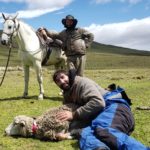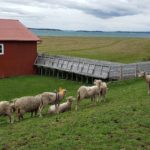
How can we use modern technology and innovation in traditional farming to become more sustainable when managing cattle and sheep? At Estancia La Península we always work towards being more sustainable, and this is why we work with scientists, e.g., within environment and innovation to learn how we can do things differently to improve our management more sustainably. We are currently collaborating with Javiera De La Fuente, who is developing a sheep tracking device and testing it at Estancia La Península.
Javiera is a teacher in Santiago with a professional background in Digital Design. In Santiago, she works in an innovation laboratory, where she learns to do diferent projects, developing devices that can collect data. In 2016 she spent some days in Estancia La Península where one of the owners of the ranch and her suddenly came up with the idea to invent a tracking device for sheep:
“I care about the environment, and my motivation has always been to find solutions for environmental problems. This is why building a sheep tracking device to avoid overgrazing and improve sustainable management interested me. Overgrazing is a major problem and causes erosion and unhealthy lands for the farmers. In the long term, it can be a huge problem for both farmers and the environment. Building a device that can provide information for farmers about their sheep and their roaming pattern can be a great help for them to improve their management”.
A tracking device can help the farmers getting real-time information about their sheep: in which areas they grass, which areas they sleep and which areas they just roam around without eating. The device can track the position of the head so for example if the head position is low, it probably means the sheep is grassing. The data can tell various things about the sheep: if the data shows that the head position hasn’t been low for days, it might indicate that there is not enough grass where it is located. It can also indicate the opposite if the sheep flock has been in the same place for various days and with the head mostly down (grazing). Then it might be time to move the sheep before they cause overgrazing and erosion. It can also indicate a pattern of where the sheep prefer to eat and which areas they pass without eating for future management.
“With this data, we will know exactly where they are and what they are doing without being there physically. Today, the farmers have to go out and search for the sheep to see where they are, which can be very time-consuming. With data being sent directly to their computer, they will be updated regularly and know where to look for them. Furthermore, with all this data, they can learn so much more about the behavior of their sheep.”
Javiera divides the project into six different stages:
- Learning about sheep and sheep farming
- Idea creation: how can we get the data via tracking
- Developing devices and testing them
- Collecting data
- Analyzing data
- Final product
Javiera is currently in stage 4, collecting data, and it hasn’t been easy to get to that point:
“I was surprised about how easy the sheep destroyed my devices, so it took a long time to build a sheep-prove device. I had to try different techniques to make sure the collar would stay on the sheep and make it in size and shape that they could not destroy. When the rams were fighting, they bang their heads together, and this caused a lot of damage to the devices and a lot of frustrations for me. I had to repair and rebuild all the time. But this is part of testing: what works and what doesn’t.”
“Testing in one of the most remote places for a reason”
Tracking devices aren’t something new, but most devices use some kind of connection, e.g., Wi-Fi to collect the data. This was one of the more significant challenges for Javiera: receiving the data when there is no good connection. Furthermore, the technology is often costly, and the return on investment would be small compared to the cost of the devices for the farmers.
“People often ask me why I choose to make this project in such a remote place like where Estancia La Península is located. But this is actually the reason. If it works in one of the most remote places with some of the most extreme weather conditions, then it will work everywhere! Besides developing a device that works in a remote area, I also try to develop an affordable device that is accessible for everybody. I am testing different types of material, types of battery, etc. to see what works the best and what would be the cheapest solution. My kind of technology already exists. I just re-invent it putting it into a new environment, a new content and a new situation. It is like crafting technology”.
“Using dogs as data collectors” After all the testing last season Javiera is now ready to collect the data. The challenge of collecting data has been made possible by the use of the dogs:
“At the beginning, I thought about just using the sheep, but since we sometimes lose signal it is difficult to collect the data. So I came up with the idea to use the shepherd dogs that live together with the sheep. This summer (2018. red.) the idea is to have a few sheep wearing the data tracker and that one of the dogs is wearing the data collector collar. When the dog is passing the sheep, the data gets collected into its data collecting device. The dogs have a certain place they go to get their food. This place will be the data transmission point where I put up another device. When the dog is at this point, the data is being sent to the estancia. Then the data gets analyzed for the farmers to understand and use e.g. telling them that they are in area X and what they are doing in this area”.
Click on the gallery below to see an illustration of how the sheep tracking and data collection system function.
When the data has been collected, next step for Javiera is to analyze the data. When she receives the data it is numbers, and these numbers need to be transformed into information that the end-user e.g. the farmers can understand and use. She hopes that within 2 years she will have the final product. She is now in Puerto Natales until March.
If you are interested hearing more about this project, please reach out to us and we will provide contact information to Javiera.She





